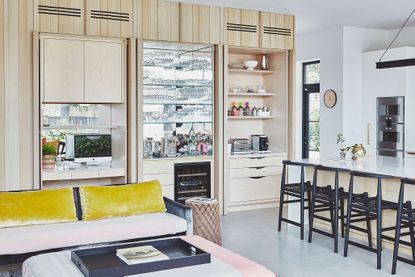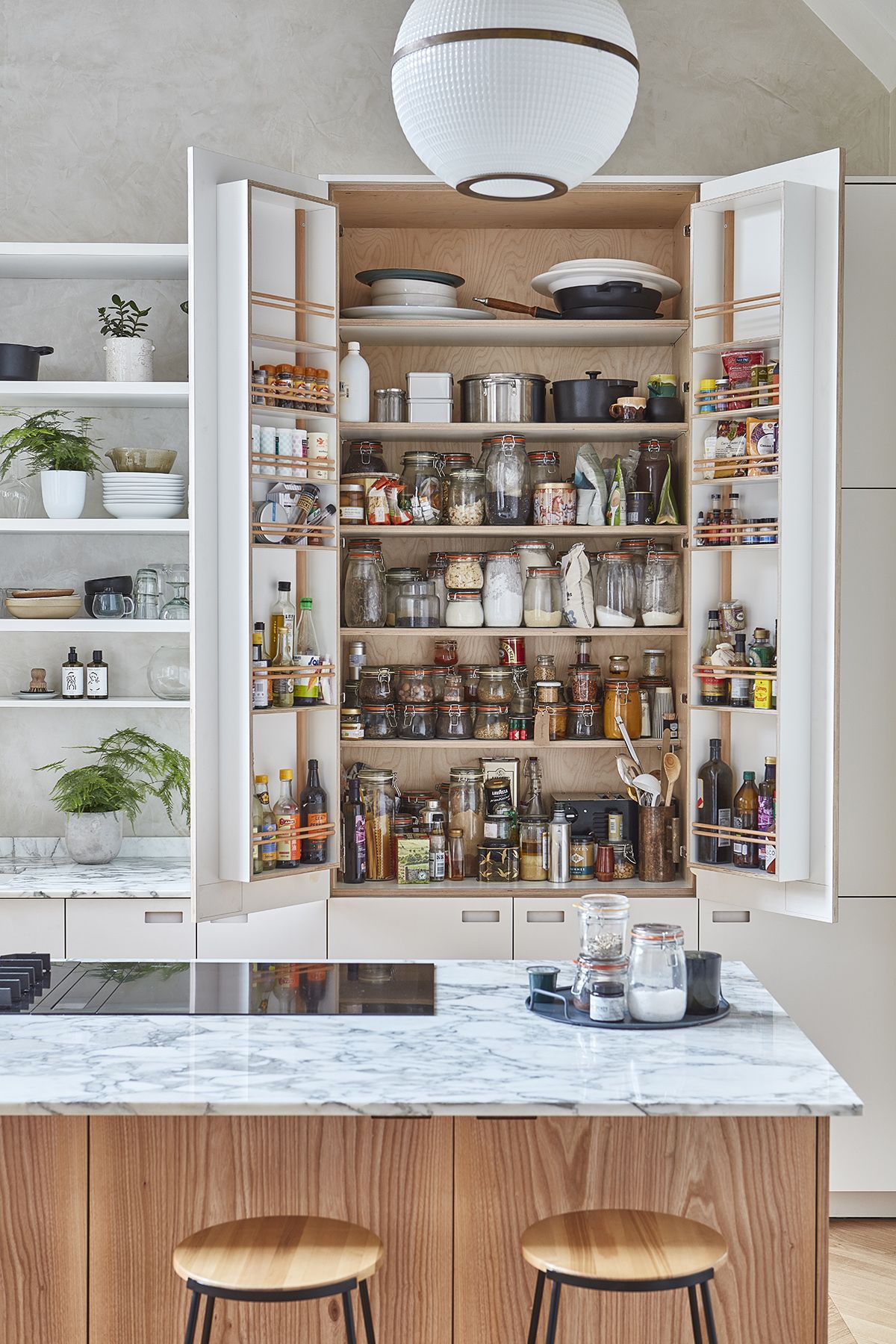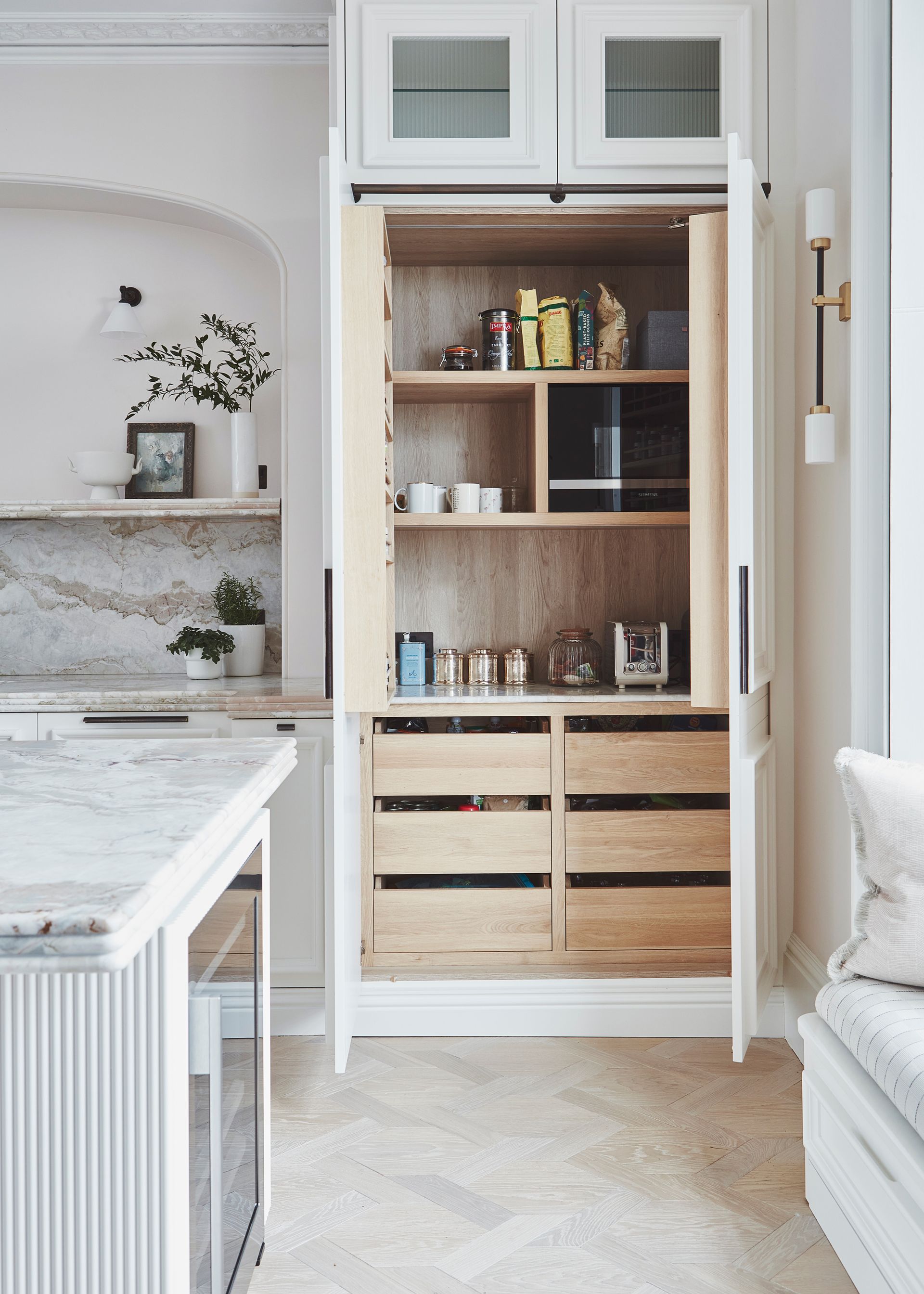Pantry storage ideas – 10 ways to expertly organize your space
Effective pantry storage ideas are key to making this hard-working space work even harder, here are our best solutions


Pantry storage ideas, for all their practicalities, really are a thing of beauty. A well-organized pantry is such a coveted thing, all those rows of lovely labeled glass jars, and perfectly stacked crockery. And as well as looking incredibly satisfying, getting your pantry storage spot on is key if you want to make this extra space work hard.
'A larder is more relevant now than ever before, as the need for compact, coherent storage space where all dry goods can go is necessary, to keep today’s often open-plan kitchens clutter-free.' explains Allison Lynch, Senior Design Consultant at Roundhouse.
'Think of a larder in the same way you would your utility room, an area where all relevant foodstuffs and kitchen equipment such as food mixers are grouped together. Consider what is to be stored/kept out of sight and/or what needs easy access. It can be as large as your space will allow or tucked in and hidden in a run of cabinetry.'
So in order to get your pantry looking and working at its best, we've rounded up plenty of storage solutions and pantry ideas to help – from simple switches like decanted your dried food, to whole overhauls of your storage system.
1. Decide on what you want to store in your pantry

Before coming up with pantry organization ideas that are going to work for you, it's important to decide exactly what you are going to store. This will help determine what type of storage you need and how it's going to fit into your space.
'Every household is different, so the first step is to sit down and consider what you want to store. This might result in racks in the doors at varying heights to store spices, jars, and bottles, and drawers – as well as shelves – inside to keep loose items organized.' explains Charlie Smallbone, founder of Ledbury Studios.
'Perhaps you want space for wine, which will require dedicated shelving, or space to keep small appliances such as a toaster, kettle, and coffee machine. If so, you’ll need to incorporate sockets. If you’re a baker, consider a marble worktop that helps dough stay cool.'
Alex Main, director of The Main Company agrees that 'Pantry storage is personal. Every household will differ so it’s important to firstly consider what you will be storing before you design your larder or pantry. If you need space for wine, for example, think about integrating some dedicated wine shelving into your larder. If you would like to keep your small appliances out of sight, consider space for your toaster, kettle and/or coffee machine to be neatly tidied away.'
2. Come up with a storage system that works for you

Once you have decided what exactly is going into your pantry then you can start coming up with a storage system that's going to work for you. This might be by 'type' eg. a shelf for baking things, a shelf for tins and condiments, a shelf solely for your ever-growing carb collection. You could organize by how frequently you use things too.
'From experience, I suggest organizing your food into sections – for example, keeping spices, pastas, baking ingredients and other dry goods together. A scattered approach makes it more difficult to find what you’re looking for while cooking. Another tip is to keep foodstuffs you use most regularly at eye level. This comes down to the individual of course, but as a cook myself I like my herbs and spices within easy reach.' explains Charlie.
Rob Lessmann, founder of Design'd Living adds, 'When it comes to pantry organization it’s important to consider looks as well as ergonomics. It makes sense for those things you use maybe once or twice a year or certainly less often, to be placed up high. However, if they’re heavy, this can make getting them down again hazardous. It’s safer to store these on the floor and build in storage and shelving that is floor to ceiling to really maximize space.'
'Working with heavy items from the floor up, then gives you space at eye level for those every day items. Group things together and use great built-in storage with pull-down racks or baskets. Just because you’re storing lots of items doesn’t mean it can’t be aesthetically pleasing. Invest in good quality boxes and baskets that work around one color theme and group items together.'
3. Trust in glass jars for the best pantry storage

Jars are a staple in any pantry. They are the easiest way to ensure the inside of a pantry is organized and yet looks aesthetically pleasing too.
'Get organized by decanting dry goods into glass storage jars and canisters, from pasta, rice to nuts and popcorn. Next, give each category its own destination according to height. We like to keep sauces, cans, and junk food away from eye level, making sure you’re always greeted by the well-organized and stylish glass jars. Group together root vegetables in handy baskets at the bottom of the pantry. They work best here as it tends to be the cooler part of the pantry.' explains Jen and Marr, founders of Interior Fox.
'Give your glass containers an upgrade with customized labels, this will help to streamline the whole look of the pantry while adding an extra element of style. Always remember to keep your labels facing forward for an easy-to-find process.'
4. Keep eveything accessible on open shelving

Pantry shelving is an excellent way to keep the space organized as everything is on show which is only going to encourage you to keep things neat and tidy. Plus shelves ensure everything is accessible, nothing is going to get lost at the backs of cupboards or in the depth of boxes.
Our top tip is not to make your shelving too deep, just enough for a couple of jars so the space doesn't get too cluttered and you can stay on top of what's on them. It also helps to label shelves if you are going store things by category. And if you don't want everything on show, include a few stylish baskets that you can hide away bulkier items. Again group things together within these so you can take the whole basket down and you have everything you need.
5. Make use of all the vertical space (even the ceiling can be useful)

In a small pantry it's important to really utilize every inch of space, so make sure you take shelving right up the ceiling and start them at floor level too. 'By going floor to ceiling with your storage you can really maximize space. If there’s room, having a built-in ladder will certainly make it easier to reach those higher shelves or a handy slim cabinet will allow for those awkward tall items like a step ladder, ironing board and mop.' explains Rob Lessmann.
The ceiling can also be valuable real estate when space is tight. If you have enough headroom you can attach hooks or a ceiling rack and use that space to hang pots and pans – saving space in your kitchen cabinets.
6. And don't forget the doors

Pantry doors can be valuable space for adding extra storage too, especially if you have a cupboard design within your kitchen rather than a spacious walk-in pantry. Line your door with slimline spice racks in order to keep your most-used spices, oils, and condiments accessible.
You could also add small hooks to the doors, and hang pots and pans or in a larger pantry add string bags that could hold any vegetables you want to store.
7. Make your pantry drawers work harder

Shelving might be the most popular pantry storage idea, but if you have the room we'd always recommend adding in some drawers too. Well-organized drawers are ideal for storing smaller miscellaneous items, tins, spices, or vegetables that don't need to be kept in the fridge like potatoes and onions.
As kitchen designer Tom Howley explains, 'Often found shoved to the back of shelves, cluttering work surfaces or amongst a hodgepodge of pantry ingredients, herbs and spices seem to be the trickiest items to keep organized in the kitchen. A bespoke drawer inlay allows you to organize your herbs and spices so that you can clearly see what you have. Not only is this more efficient when cooking, but storing them in a cool, dark drawer can extend the life and flavor of your spices.
8. Create a breakfast station for storing every day appliances

Pantry storage needn't always be about storing foodstuffs, in fact, they are the perfect space for hiding away appliances that would otherwise be cluttering up a kitchen countertop. A 'breakfast pantry' as they are now being coined, store coffee machines, kettles, toasters etc. so you have everything you need in the mornings all in one spot. You can even have a microwave built-in.
'Pantries are a great way to hide a multitude of sins in a kitchen.' explains Magnus Nilsson, Lead Designer at Blakes London. 'For a busy family, a breakfast station hidden behind retractable doors can be an immensely practical addition to your home. A place where you can prepare a bowl of cereal, or slice of toast while grabbing a coffee means that the mess is contained.'
'And if time really is at a premium, which let's be honest it is for most of us in the mornings, you can always shut the door on the mess and leave it for a later date without compromising the look and feel of the rest of the kitchen, or indeed house.'
9. Maximize a small pantry with pull out storage

'If space is not an option, then don’t worry, there are pull-out storage solutions that are perfect to maximize smaller spaces. If you often find yourself awkwardly stretching to the back of your cupboards to reach items in hard-to-reach areas, for example, then a pull-out pantry offers the perfect solution.' explains Ruth Lavender designer at Benchmarx.
'If there’s any awkward slim spaces, look at installing a tall thin pull-out spice rack. If you love your spices this could deliver a huge amount of space in a very small opening.' suggests Rob.
10. Ensure everything stays put

Hardly a glamourous pantry storage idea but an essential non the less, nonslip drawer and shelf liner will ensure everything in your pantry stays put. There are some really subtle designs that you won't even notice but will prevent any things flying out of drawers when you open them or bags of cereal toppling off the top shelf.
'To avoid breakages and the potential for spillages, use anti-slip trays and soft close mechanisms as the larder is a place that will typically store sharp kitchen utensils and cookware, through to heavy jams and preserves and glass bottles filled with oil and vinegar, all of which add weight and require a firm footing.' explains Simon Bodsworth, Managing Director at Daval.
How do you get more storage in a pantry?
To get more storage out of a pantry you have to make all the elements work harder. Double your shelf space with shelf inserts, maximize drawer space with pull-out systems and ensure you are only storing things you need and use regularly. Time to ditch the spiralizer.
'Small mezzanine racks provide additional storage space in cupboards with pull-out rack systems and combination shelving standing firm as a way to create one complete area which caters to multiple needs.' explains Simon Bodsworth.
Annie Ebenston, Lead Designer at Blakes London adds, 'When designing your pantry it's worth taking the time to think about the specifics of the items that you wish to store within it and how often they are used. Think about the heights of shelves and which family members can reach them, as well as your ratio of drawers to shelves.'
'Do you store your root veg in the fridge for example, or would open baskets in a pantry be better, will cereal boxes be stored up high out of reach of children but where there may be more room for taller, lighter items, or do you need the shelves to start higher in order to accommodate taller items and bottles at lower levels? Do you want to store bottles and spices in the pantry, commonly in a door, or do they have a home elsewhere? By considering these everyday practical lifestyle-related activities in advance and designing your pantry accordingly, you will ensure that this special little cupboard will be the workhorse of your kitchen to rival any fridge!'
What should be stored in a pantry?
See a pantry just like additional kitchen storage, it's a place to store bulkier items that perhaps won't fit in your cabinets, or don't need to be instantly accessible. Pantries are of course primarily for food-stuffs – 'A well-planned larder is a home for storage for all your non-perishables, dry goods, vegetables, bottles, anything you need to see in one hit. It will be equipped with everything from open vegetable racks to wine storage, deep drawers, and plenty of open shelving. Some even have sinks for prepping vegetables and marble shelves for cooler storage.' explains Alison Lynch.
Be The First To Know
The Livingetc newsletter is your shortcut to the now and the next in home design. Subscribe today to receive a stunning free 200-page book of the best homes from around the world.
Hebe is the Digital Editor of Livingetc; she has a background in lifestyle and interior journalism and a passion for renovating small spaces. You'll usually find her attempting DIY, whether it's spray painting her whole kitchen, don't try that at home, or ever changing the wallpaper in her hallway. Livingetc has been such a huge inspiration and has influenced Hebe's style since she moved into her first rental and finally had a small amount of control over the decor and now loves being able to help others make decisions when decorating their own homes. Last year she moved from renting to owning her first teeny tiny Edwardian flat in London with her whippet Willow (who yes she chose to match her interiors...) and is already on the lookout for her next project.
-
 How to Thaw a Frozen Pipe — Learn Everything You Need to Know in 5 Minutes With This Guide
How to Thaw a Frozen Pipe — Learn Everything You Need to Know in 5 Minutes With This GuideWinter storm caught you off guard? We asked an expert — just how do you thaw a frozen pipe?
By Hugh Metcalf Published
-
 The 12 Very Best Silk Bedding Pieces — As Our Style Editor Says: 'It's What Dreams Are Made Of!'
The 12 Very Best Silk Bedding Pieces — As Our Style Editor Says: 'It's What Dreams Are Made Of!'Slumber in lustrous luxury with the very best silk bedding sheets, duvets, pillowcases, and more — your sleep score will thank us later
By Julia Demer Published

